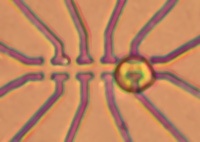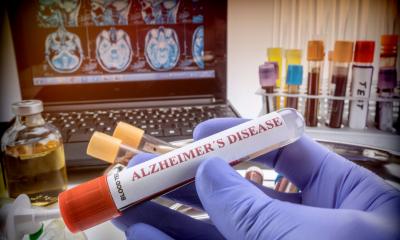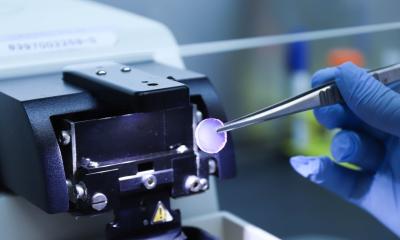A new study could revolutionise drug testing
Researchers have made a breakthrough by detecting the electrical equivalent of a living cell's last gasp. The work takes them a step closer to both seeing the 'heartbeat' of a living cell and a new way to test drugs.

An optical microscope image of a yeast cell (the round feature to the right) on top of the micron-sized detector used in the studies. The image is blurred because the cell is so small that large magnification is required in order to obtain the image.
To stay alive, individual biological cells must transfer electrically charged particles, called ions across their cell membranes. This flow produces an electrical current that could, in principle, be detected with sensitive enough equipment. The recognition of such electrical activity would provide a kind of 'cellular cardiogram', allowing the daily functioning of the cell to be monitored in a similar way to a cardiograph showing the workings of a human heart.
With funding from the Engineering and Physical Sciences Research Council (EPSRC), Professor Andre Geim at the University of Manchester and his team have set out to make the first measurement of a cellular 'heartbeat'.
"Once we know the average or usual pattern of electrical activity in a cell, we can see how different drugs affect it," says Professor Geim. This would put an early safeguard into the system that could be applied long before the drug was tested on animals or even humans. In addition, the electrical activity test could be used to monitor the effects of pollution on naturally occurring micro-organisms in the environment.
To detect a cell's normal activity, Andre Geim and fellow researchers modified apparatus used originally to detect weak magnetic fields in superconductors*. Unfortunately, these modifications reduced the sensitivity of the technique, and the normal activity of the yeast cell could not be detected. This is the first time such a technique has been used on a living cell.
Not to be defeated, the researchers went about livening things up. They chose to invoke what any self-respecting party-goer would: alcohol. "We added ethanol – which is essentially vodka – to provoke a response from the cell. Ethanol is known to increase the transparency of cellular membranes which we hoped would give a signal we could detect," says Dr Irina Barbolina, who carried out the experiments.
It worked. As soon as the yeast got a taste of the vodka, the probe registered an electrical signal. A drunken hiccup perhaps? "It was probably the last gasp of the dying cell," says Professor Geim. The researchers had added so much ethanol that it poisoned the cell.
Although not the cardiogram they had hoped for, the electrical signal was the smallest yet detected from a living cell, around 100 times smaller than anything previously detected. It added up to an electrical current of just 10 moving electrons. It has given the team confidence that equipment sensitive enough to measure a cell's heartbeat can be developed.
"We already have some ideas about how to improve the sensitivity of the detector in water and next time we will also use a more active micro-organism such as an amoeba. Yeast is a subdued organism and doesn’t generate much activity," says Professor Geim. "Probably, the most important outcome is that we defined an important goal. Cellular cardiograms can no longer be seen as absurd or science-fictional. If not us then someone else will soon develop a technique sensitive enough for such studies."
25.04.2007
More on the subject:











